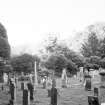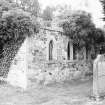Pricing Change
New pricing for orders of material from this site will come into place shortly. Charges for supply of digital images, digitisation on demand, prints and licensing will be altered.
Upcoming Maintenance
Please be advised that this website will undergo scheduled maintenance on the following dates:
Thursday, 9 January: 11:00 AM - 3:00 PM
Thursday, 23 January: 11:00 AM - 3:00 PM
Thursday, 30 January: 11:00 AM - 3:00 PM
During these times, some functionality such as image purchasing may be temporarily unavailable. We apologise for any inconvenience this may cause.
Ancrum, Old Ancrum Church, Graveyard
Burial Ground (Medieval), Gravestone(S) (18th Century), Hogback Stone (Early Medieval)
Site Name Ancrum, Old Ancrum Church, Graveyard
Classification Burial Ground (Medieval), Gravestone(S) (18th Century), Hogback Stone (Early Medieval)
Alternative Name(s) Livingston Church
Canmore ID 96330
Site Number NT62SW 2.01
NGR NT 6215 2485
Datum OSGB36 - NGR
Permalink http://canmore.org.uk/site/96330
- Council Scottish Borders, The
- Parish Ancrum
- Former Region Borders
- Former District Roxburgh
- Former County Roxburghshire
Ancrum 1, Roxburghshire, fragment of panel
Measurements: H 256mm, W 315mm, D 75mm
Stone type: cream coloured Old Red Sandstone
Place of discovery: NT c629245
Present location: Jedburgh Abbey Museum, incorporated into the roof of the shrine reconstruction.
Evidence for discovery: the fragment was found in a garden near Ancrum in 1903 and brought to Jedburgh Abbey at an unknown later date. Its original provenance is unknown, although it may have come from the Old Ancrum churchyard to the north-west of Ancrum village.
Present condition: good
Description
This is a fragment from a panel, carved in relief with plaitwork and a plain border along one edge. There is no reason to associate it with the Jedburgh shrine panel, though it could have come from a shrine or chancel screen (Cramp 1983: 281).
Date: ninth century
References: Laidlaw 1905: no 10; RCAHMS 1956, 207-8; Cramp 1983: fig 120c.
Compiled by A Ritchie 2016
Ancrum 2, Roxburghshire, hogback grave-cover
Measurements: L 2.70m, W 0.52m to 0.36m, H 0.29m to 0.28 high at ends, max height 0.34m.
Stone type: old red sandstone
Place of discovery: NT 6215 2485
Present location: Old Ancrum churchyard, south of the ruined church, now protected by a wooden cover and no longer visible.
Evidence for discovery: found in 1922 by R Robson, at which time the top of the stone was visible above the turf, and excavated that same year by J Hewat Craw. Re-excavated by J N G Ritchie and J T Lang in 1969. The stone was taken up for conservation in 2018.
Present condition: very poor: extremely friable sandstone, serious longitudinal fractures and flaking.
Description
This hogback has a double ridge with a central groove and five rows of semicircular tegulae on either side. Each tegula is about 0.08m wide and 0.06m high on a flat pitch, and below them are incised eaves above plain flat sides, 0.1m high. The ends are truncated, and the stone is set on a plain plinth, presumably the top cover of the grave for which it was re-used.
Date: early twelfth century
References: Craw 1922, 188; RCAHMS 1956, no 1; Lang 1974, 223; DEA 2018, 172-3.
Compiled by A Ritchie 2016
NT62SW 2.01 6215 2485
Beneath the turf of the church-yard, about 20yds S of the ruin, there lies a hog- backed stone about 6ft 4in in length, ornamented on both sides with five rows of shingle ornament. It was recorded in 1922, when more of the stone appears to have been above the surface, that its breadth was 1ft 10in at the head and 1ft 2in at the foot, and its height 1ft at either end and 1ft 1 1/2in in the middle. (J H Craw 1922). The churchyard also contains two small headstones of earlier date than 1707. The first, which has a shaped top, is carved on one side with a winged hour-glass, a skull, and a cherub's head. Behind the skull runs a scroll, bearing a motto in two lines, only the first words of each, respectively LIVE and MINDE, being legible today. On the back runs the inscription HERE LYES/IAMES LIGERTUOD/TENNANT IN H(OU)/ NDLIE UHO DIED/SUPTR 14 1621/HIS AGE 74/AS ALSO ISOBELL/LIGERTWOOD DAUT(E)R/TO WALTER LIGERT/UOOD TENNANT IN/MENHOUSE WHO DIED/ OCTBR 16 1720 HIR AGE 25. The second stone, also with a shaped top, displays in front a crudely carved skull and cross-bones, while the back bears the inscription HERE LYES/ADAM RICHARDSON/ WHO LIVED IN ANE ONEST REPUT ALL/HIS DAYES AND DIED/ IN OCTOBER THE 19/1701 AND OF HIS/AGE 55.
Bell.
Visited by RCAHMS 22 March and 13 October 1933
RCAHMS 1956
The hog-backed stone was located at NT 6215 2485, protruding slightly above the turf. The headstones described by the RCAHMS are still evident.
Visited by OS (WDJ) 23 January 1967
Field Visit (22 March 1933 - 13 October 1933)
Parish Church, Hog-backed Stone, etc.
The former parish church of Ancrum is now reduced to its foundations. Beneath the turf of the church-yard, about 20yds S of the ruin, there lies a hog- backed stone about 6ft 4in in length, ornamented on both sides with five rows of shingle ornament. It was recorded in 1922, when more of the stone appears to have been above the surface, that its breadth was 1ft 10in at the head and 1ft 2in at the foot, and its height 1ft at either end and 1ft 1 1/2in in the middle (Craw 1922, 188).
The churchyard contains only one stone of earlier date than 1707. This, a small headstone, has a shaped top, has a shaped top and displays in front a crudely carved skull and cross-bones, while the back bears the inscription HERE LYES / ADAM RICHARDSON / WHO LIVED IN ANE ONEST REPUT ALL / HIS DAYES AND DIED / IN OCTOBER THE 19 / 1701 AND OF HIS / AGE 55.
Bell.
The bell of the modern parish church [NT62SW 195], now inaccessible, is understood to bear the inscription MICHAEL BVRGERHBVYS ME FECIT 1618.
RCAHMS 1956, visited 22 March and 13 October 1933.
Photographic Record (1986)
Recording of gravestones in the graveyard of Old Ancrum Church, Roxburghshire, by Mrs Betty Willsher 1986.
Conservation (August 2018)
NT 6215 2485 The society is undertaking, August 2018 –
ongoing, a project to preserve the ‘hogback’ stone in the
village kirkyard. As CANMORE states ‘Present condition:
very poor: extremely friable sandstone, serious longitudinal
fractures and flaking.’ Though commonly referred to as a
‘hogback’ it is more properly described as a 12th-century
coped grave cover with tegulations. Under the supervision
of archaeologist John Dent, the stone has been lifted and the
area subjected to a small excavation. There was no grave
under the stone, but it was resting on two pieces of masonry,
which appear to have come from the ruined church. It is
possible that the graveslab was originally in the chancel
of the old kirk and was removed when family vaults were
created in the 19th century. It was rediscovered in the 1920s
in its present position (before lifting operations).
Archive: To be determined
Geoff Parkhouse – Ancrum and District Heritage Society
(Source: DES, volume 19)
Sbc Note
Visibility: This is an upstanding earthwork or monument.
Information from Scottish Borders Council






























